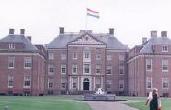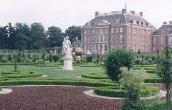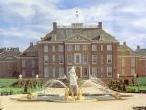











 Paleis Het Loo reflects the historical ties between the House of Orange-Nassau and the Netherlands. The central part of the palace and the lateral pavillions show how the palace was inhabited by the House of Orange for three centuries starting with the King Stadtholder William III up to and including Queen Wilhelmina.
Paleis Het Loo reflects the historical ties between the House of Orange-Nassau and the Netherlands. The central part of the palace and the lateral pavillions show how the palace was inhabited by the House of Orange for three centuries starting with the King Stadtholder William III up to and including Queen Wilhelmina.
 In November 1684 Prince William III of Orange, then Stadtholder of Gelderland, purchased Het Loo with the intentions of building a palatial hunting lodge somewhere on the property. On April 5, 1685 the first contract was tendered and in September of the same year the stonework of the middle section (or corps de logis) of what came to be known as Het Loo was completed. In 1686, the year given on the facade of the building, the wings, originally linked by colonnades to the corps de logis were added, the walls were built and the gardens were laid out.
In November 1684 Prince William III of Orange, then Stadtholder of Gelderland, purchased Het Loo with the intentions of building a palatial hunting lodge somewhere on the property. On April 5, 1685 the first contract was tendered and in September of the same year the stonework of the middle section (or corps de logis) of what came to be known as Het Loo was completed. In 1686, the year given on the facade of the building, the wings, originally linked by colonnades to the corps de logis were added, the walls were built and the gardens were laid out.
 Het Loo became the favorite hunting seat and country palace of William III and his wife Princess Mary II, and until his death in 1702 furnishings and decorations both inside and outside underwent repeated alterations and embellishments. At that time symmetry was considered ideal and the design for the building and grounds featured a central axis with mirror image components on either side. Inside the palace the axis consisted of the Entrance Hall, the Staircase and the Great Hall on the first floor. West and east of the Great Hall respectively were the apartments of William III and Mary II. The apartments of the courtiers and the Dining Room were on the ground floor.
Het Loo became the favorite hunting seat and country palace of William III and his wife Princess Mary II, and until his death in 1702 furnishings and decorations both inside and outside underwent repeated alterations and embellishments. At that time symmetry was considered ideal and the design for the building and grounds featured a central axis with mirror image components on either side. Inside the palace the axis consisted of the Entrance Hall, the Staircase and the Great Hall on the first floor. West and east of the Great Hall respectively were the apartments of William III and Mary II. The apartments of the courtiers and the Dining Room were on the ground floor.
 In 1689 William III became King of England and this elevation of his position and power brought an enlargement of Het Loo in its wake. Between 1691 and 1694 the colonnades which linked the corps de logis to the wings on either side were replaced by four pavillions. These pavillions contained the new apartments of William III and Mary II, a new Dining Room, a Long Gallery and a Chapel. Queen Mary did not return to Holland after 1689 and never saw the enlargement.
In 1689 William III became King of England and this elevation of his position and power brought an enlargement of Het Loo in its wake. Between 1691 and 1694 the colonnades which linked the corps de logis to the wings on either side were replaced by four pavillions. These pavillions contained the new apartments of William III and Mary II, a new Dining Room, a Long Gallery and a Chapel. Queen Mary did not return to Holland after 1689 and never saw the enlargement.
 On the death of King William III in 1702 there was disagreement about his inheritance, but eventually, in 1732, Het Loo descended to Willem IV (1711-1751) who was, from 1747, Stadtholder of all the provinces. Both Willem IV and his son Willem V (1748-1806) used the palace in the 18th century as a summer residence.
On the death of King William III in 1702 there was disagreement about his inheritance, but eventually, in 1732, Het Loo descended to Willem IV (1711-1751) who was, from 1747, Stadtholder of all the provinces. Both Willem IV and his son Willem V (1748-1806) used the palace in the 18th century as a summer residence.